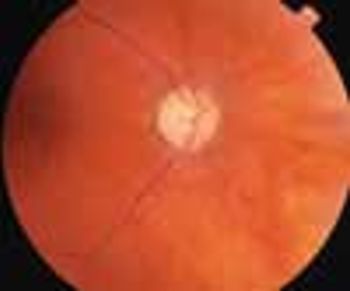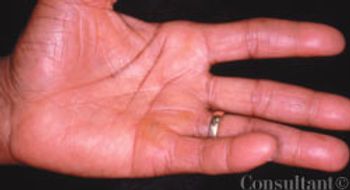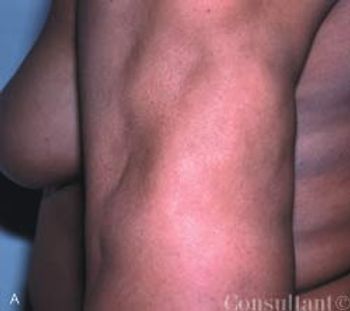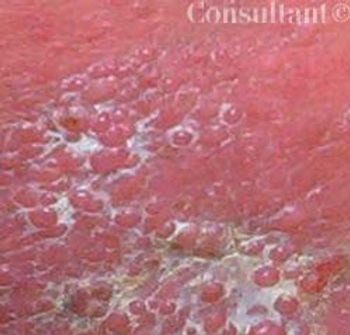
We have recently had an upsurge in children with type 1 diabetes at our gastroenterologyclinic for celiac screening.

We have recently had an upsurge in children with type 1 diabetes at our gastroenterologyclinic for celiac screening.

ABSTRACT: To assess a child for overweight, begin by calculating his or her body mass index (BMI). Note that BMI is used differently in children than it is in adults. A child's BMI is plotted on a growth curve that reflects that child's age and gender. This yields a value-BMI-for-age-that provides a consistent measure across age groups. Children whose BMI-for-age is between 85% and 95% are at risk for becoming overweight. Any child whose BMI-for-age is 95% or more is considered overweight. The 2 main factors associated with overweight in children are poor eating habits and decreased physical activity. Recommend that children have at least 5 servings of fruits and vegetables a day. Children should engage in moderate physical activity for at least 60 minutes on most days of the week, and TV viewing and computer activities should be limited to no more than 2 hours a day.

ABSTRACT: The Studies of Left Ventricular Dysfunction (SOLVD) trials demonstrated that early intervention in congestive heart failure (CHF) improves survival. However, early CHF is mainly a clinical diagnosis based on New York Heart Association criteria and, until recently, no easy and inexpensive screening test existed. There are now several such tests that employ radioimmunoassays (RIAs) to measure cardiac peptides in a single plasma sample; results help determine the likelihood that CHF is present but do not definitively establish the diagnosis. The vessel dilator RIA is the most specific and sensitive for differentiating persons with mild CHF from healthy ones; intravenous administration of this cardiac peptide hormone has beneficial hemodynamic, diuretic, and natriuretic properties in persons who have CHF. Brain natriuretic peptide (BNP) measured by fluorescence immunoassay is useful in the emergency department, because a result may be obtained in as little as 15 minutes. This assay may indicate CHF; further tests are recommended to define the diagnosis. BNP increases with other causes of dyspnea, including pulmonary hypertension, pulmonary emboli, and renal failure, so it is not specific for CHF. BNP also increases with age, and measured values are higher in women than in men.

A 60-year-old woman with hypertension, diabetes mellitus, and intermittentatrial fibrillation presents with nausea, diaphoresis, dizziness, and globalweakness that has lasted 1 hour. She denies chest pain, dyspnea, syncope,vomiting, diarrhea, blood loss, and headache; there is no vertigo. Medicationsinclude acetaminophen, digoxin, diltiazem, glipizide, hydrochlorothiazide,irbesartan, metformin, pioglitazone, and warfarin.

Swelling of the lower legs broughtthis 57-year-old woman to a familypractice clinic. She had a history ofhyperthyroidism with weight loss,tachycardia, and anxiety. This conditionwas confirmed with blood testsand radioactive iodine uptake testing.

This 17-year-old presented with a 1-month history of weight loss, increased appetite, mild insomnia, hand tremor, palpitations, sweating, heat intolerance, and quick loss of temper. The number of daily bowel movements had increased from 1 to 2. There was no family history of thyroid disorders.

Graves disease presents commonly with exophthalmos and stare and striking pretibialmyxedema.

Hyperpigmentation is seen on the cheeks and eyelids of a 36-year-old woman.She became hyperthyroid at age 19 years, with accompanying exophthalmosand hyperpigmentation, following the birth of her first child. Thyroidectomywas carried out at that time, and the patient has been receiving thyroid replacementtherapy ever since. The hyperpigmentation, an uncommon accompanimentof hyperthyroidism, has persisted.

Apidra (insulin glulisine injection)from Aventis is approved by the FDAfor use in adult patients with type 1 ortype 2 diabetes mellitus for the controlof hyperglycemia. Compared withhuman insulin, Apidra has a morerapid onset and a shorter duration ofaction. The drug is designed to managemealtime spikes in glucose levelsby administration through subcutaneousinjection or continuous subcutaneouspump infusion either 15 minutesbefore or 20 minutes after startinga meal.

ABSTRACT: The chief causes of ingrown toenails are trauma, incorrect toenail trimming, and tight footwear. Conservative measures, which include decreased activity, warm soaks, antibiotic therapy, elevating the edge of the impinged nail, debridement, or removal of the corner of the toenail containing the spike, may relieve moderate inflammation and infection. For patients who have severe impingement with acute infection, partial or complete nail avulsion is the treatment of choice. If avulsion is followed by recurrent infection, partial or complete ablation of the nail matrix may become necessary after the infectious process has resolved. Teach patients to trim their toenails straight across and not to curve them toward the lateral margins.

Over the previous 6 months, a59-year-old man had experienced lethargy,fatigue, poor appetite, cold intolerance,and abdominal distention. Hisvital signs were normal; physical examinationrevealed periorbital andpretibial edema, distant heart sounds,and delayed reflexes.

To distinguish between hypertensive emergencies and urgencies and nonurgent acute blood pressure elevation, evaluate the patient for evidence of target organ damage. Perform a neurologic examination that includes an assessment of mental status; any changes suggest hypertensive encephalopathy. Funduscopy can detect papilledema, hemorrhages, and exudates; an ECG can reveal evidence of cardiac ischemia. Order urinalysis and measure serum creatinine level to evaluate for kidney disease. The possible causes of a hypertensive emergency include essential hypertension; renal parenchymal or renovascular disease; use of various illegal, prescription, or OTC drugs; CNS disorders; preeclampsia or eclampsia; and endocrine disorders. A hypertensive emergency requires immediate blood pressure reduction (although not necessarily to the reference range) with parenteral antibiotics. An urgency is treated with combination oral antihypertensive therapy.

Vague abdominal pain, malaise, anorexia,and the loss of 10 lb in 2months prompted a 65-year-old manto seek medical evaluation. A yearearlier he had undergone surgery forstage III carcinoma of the sigmoidcolon. Because metastases to thelymph nodes were found in the resectedcolon, the patient was given postoperativechemotherapy. Histologicexamination revealed poorly differentiatedadenocarcinoma.

An 85-year-old man was admitted to the hospital with acough and shortness of breath of 1 week’s duration anda fever and increased sputum production for 2 days. Hishistory included renal cell carcinoma and metastatic renalcancer for 2 years. The patient had smoked cigarettesfor 30 years. He had lost 30 lb during the last few months.A chest film revealed pneumonia of the right lowerlobe. Metastatic nodules were noted on the scalp; extensivelung, bone, and brain metastases also were found.

A 40-year-old man was concerned about an enlarging painlessmass on the right side of his neck that had been presentfor 6 months (A). The patient reported no other healthproblems; his medical history was unremarkable, and hewas taking no medications.There was no family or personal history of thyroiddisease or of exposure to radiation. Thyroid function testresults were within normal limits. A chest film revealed nopathology.

Is hypertension a frequent manifestation of thyroid disease?Which clinical clues suggest hypertension in persons with thyroiddysfunction?

An 86-year-old woman had noted intermittent, transient “shading” and “hazing” of the vision in her right eye. Her best corrected vision in that eye was 20/20. She had pseudophakia from past cataract surgery.

An 87-year-old woman complained ofseeing a red tinge on the wallpaper inher house through her right eye. Thepatient had mild memory loss andmoderate hypertension, for whichshe took atenolol. She had quit smokingcigarettes many years earlier.

During an annual eye examination, a 65-year-old womanwith a 5-year history of type 2 insulin-dependent diabetescomplained that her vision had slightly worsened in botheyes. Her best corrected visual acuity was 20/30 in botheyes.

Sudden profound vision loss in her left eye prompted an82-year-old woman to seek evaluation. She also complainedof “just not feeling well” and reported new-onsettemporal and occipital headaches of 6 weeks’ duration.

A 49-year-old woman presented for aroutine eye examination. She had nohistory of systemic disease and tookno medications.

For 3 years, a linear plaque had been slowly developing on the left palm of a 47-year-old woman who had difficulty in opening and closing her hand. There was no contributory family history.

ABSTRACT: In high-risk patients with vascular disease, blockade of the renin- angiotensin system (RAS) can help prevent cardiac remodeling that ultimately results in left ventricular hypertrophy (LVH) and heart failure. Optimal treatment of these patients, who often have diabetes or renal disease, usually involves a combination of agents-1 of which should be a thiazide diuretic-to reduce blood pressure, control the comorbid condition, and prevent end-stage organ damage. The manner in which the RAS is interrupted may be important. For example, although a thiazide diuretic and an angiotensin-converting enzyme (ACE) inhibitor are recommended for hypertensive patients with LVH, an angiotensin II receptor blocker (ARB) in combination with a diuretic was recently found to reduce cardiovascular morbidity and mortality in these patients to a greater degree than a ß-blocker/diuretic. Both ACE inhibitors and ARBs delay the progression of diabetic nephropathy and reduce albuminuria. ARBs were recently shown to reduce progression from microalbuminuria to macroalbuminuria. In patients with systolic heart failure who cannot tolerate ACE inhibitors, an ARB can be used with a ß-blocker.

A 1-year history of “dents” on her body prompted a 40-year-old African American woman to seek medical evaluation. Her medical history was unremarkable; however, there was a strong family history of severe type 2 diabetes mellitus. The patient denied having received or having self-administered injections into the affected areas. She reported no history of deep, tender nodules at the sites.

A 62-year-old obese woman with adult-onset type 1 diabetes mellitus had a 6-year history of bilateral leg edema. During the last year, the edema worsened and the skin on her legs thickened. She also had multiple, bilateral, painful, superficial ulcers that drained copiously.